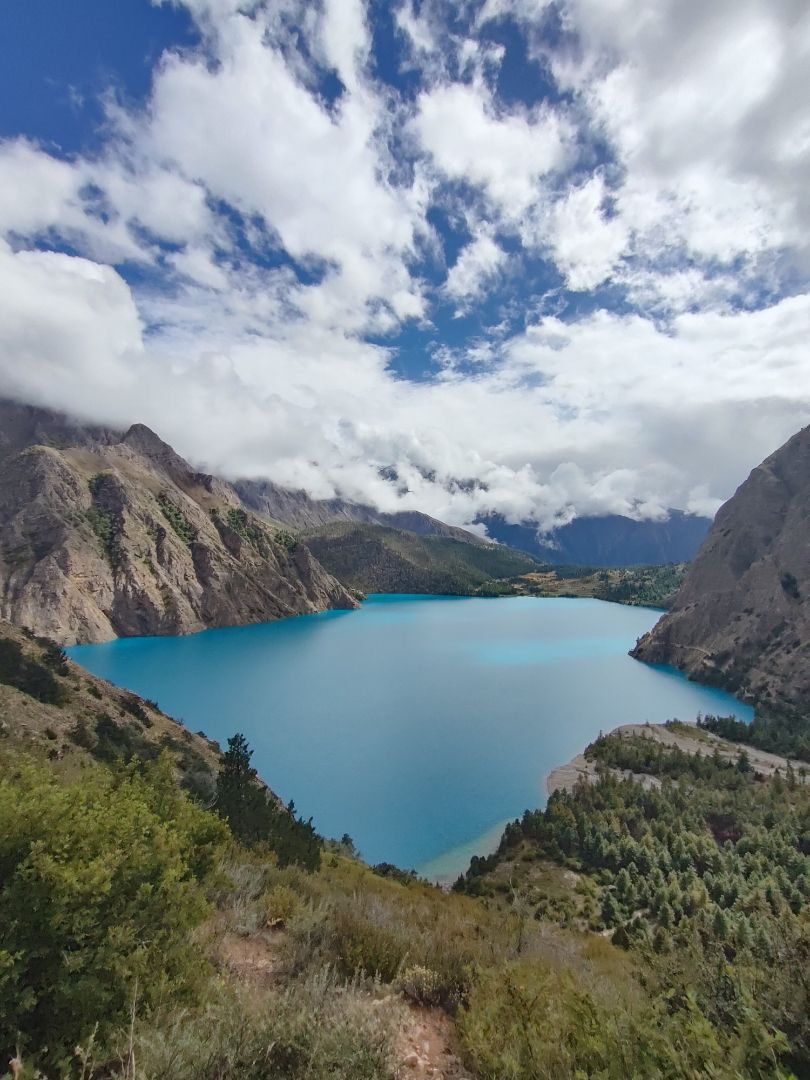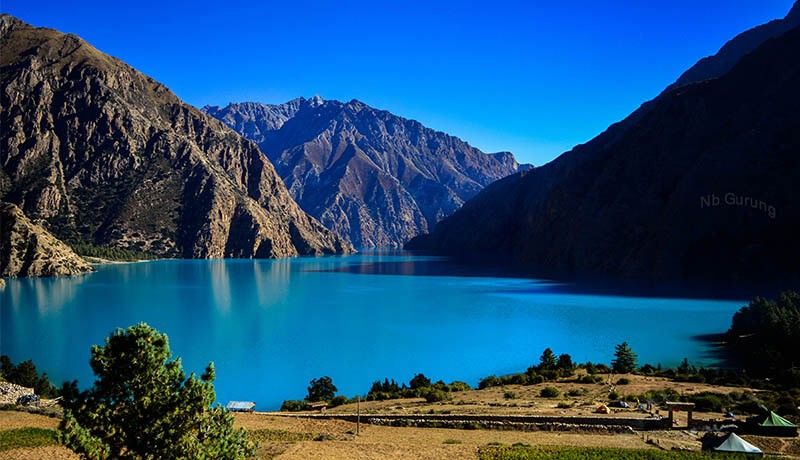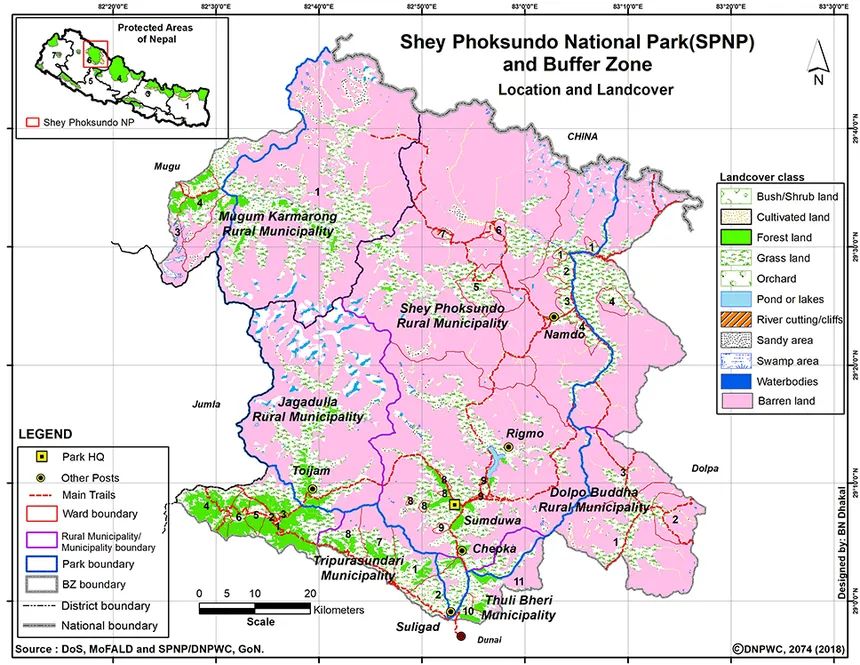About Phoksundo
Journey into the heart of the Himalayas to discover Nepal's most sacred alpine lake and its ancient cultural treasures
The Precious Lake of Dolpo
Phoksundo Lake, known locally as "Rigmo" meaning "the precious one," is a pristine alpine lake nestled in the remote Dolpo region of northwestern Nepal. At 3,611 meters above sea level, it stands as the deepest lake in Nepal and one of the highest freshwater lakes in the world.
The lake's stunning turquoise waters are created by its remarkable depth of 145 meters and high mineral content. Surrounded by barren cliffs, snow-capped peaks, and ancient monasteries, Phoksundo creates an otherworldly landscape that has remained virtually unchanged for millennia.
Lake Facts
145m deep • 5.15 km² surface area • Turquoise waters
Altitude
3,611m above sea level • Trans-Himalayan region

Park History
The journey from wildlife reserve to Nepal's largest national park
Timeline
Established as Shey Phoksundo Wildlife Reserve to protect the region's delicate ecosystems
Upgraded to National Park status, becoming Nepal's largest national park

The park was established with the intention of safeguarding the region's delicate ecosystems and distinctive biodiversity. Named after Phoksundo Lake, Nepal's deepest lake, and Shey Monastery, a centuries-old Buddhist monastery within the park's boundaries.
The native Tibetan and Bonpo people have inhabited this area for many centuries. Their customs, including transhumance and yak herding, have shaped the landscape and contributed significantly to the region's cultural value.
Through community-based conservation programs and sustainable tourism practices, Shey Phoksundo National Park exemplifies Nepal's commitment to protecting its rich natural heritage and diverse cultural legacy for future generations.
Key Facts
Essential information about this remarkable alpine destination
Deepest Lake
At 145m deep, Phoksundo is Nepal's deepest alpine lake
The lake's depth and mineral content create its distinctive turquoise color
High Altitude
Located at 3,611m in the Trans-Himalayan region
Situated in the rain shadow of the Himalayas, creating a unique ecosystem
Cultural Heritage
Sacred to both Bon and Buddhist traditions
Home to ancient monasteries and pilgrimage sites dating back centuries
Protected Area
Part of Shey Phoksundo National Park since 1984
Nepal's largest national park protecting unique Trans-Himalayan biodiversity
Phoksundo Lake Trek: Dolpo Villages
Discover ancient villages on the Phoksundo Trek in Dolpo
Explore traditional Dolpo villages on the Phoksundo Lake Trek, from the turquoise Shey Phoksundo Lake to locations featured in the Phoksundo Lake Nepal map. Learn about Phoksundo Lake altitude, weather, detailed trek itineraries, maps, routes, lake height, and estimated trekking costs.

Shey Phoksundo National Park
Ringmo (Tshowa) Village
A charming settlement on the banks of the stunning Phoksundo Lake, Ringmo is renowned for its breathtaking natural beauty and traditional Tibetan Buddhist culture. Locally known as ''Tsho-wa,’’ meaning lakeside village in Tibetan, this hidden gem of Nepal is located at an elevation of 3,660 metres in the lower Dolpo region, surrounded by thick alpine forest. Best known as a living museum, it showcases ancient highland ways of living, with locals preserving their culture and traditions.

Upper Dolpo Region
Saldang Village
One of the largest settlements in the region and a vital center for trade and commerce, Saldang sits in the heart of upper Dolpo at an elevation of 3,770 meters above sea level, near the Tibetan border. Known for its cold, deserted landscapes and surreal high mountain passes, this village is distinguished by its historic stone houses, terraced barley fields, and ancient monasteries. Reaching Saldang requires physical and mental fitness due to its location behind a mountain pass at 3,856m, serving as a turning point for the Dho Tarap valley.

Heart of Tarap Valley
Dho Tarap Village
A picturesque settlement nestled in the scenic Tarap Valley, Dho Tarap is celebrated for its rich cultural heritage at an elevation of 4,067 meters above sea level, one of the highest human settlements in the world. Formed by the combination of 'Dho' and 'Tokyu' settlements, this largest village in the Dolpo region was once a major trading hub. Surrounded by high mountain passes and seasonal vegetation like wheat, potatoes, and celestial barley, it showcases traditional stone houses with elaborate wood carvings, colorful prayer flags, and numerous important monasteries.
Festivals & Culture
Living traditions where ancient Tibetan Buddhist and Bon practices continue to flourish, creating a vibrant cultural tapestry in Upper Dolpo.

Shey Gompa Festival
The Shey Gompa Festival, centered around Shey Monastery in Upper Dolpo, is a spiritually significant event honoring the sacred circumambulation (Kora) of Crystal Mountain, revered as the 'Kailash of Dolpo.' It features lama dances, horse racing, archery, chants, and prayers. This rare gathering preserves Bon and Tibetan Buddhist traditions, fostering community bonds in Nepal's isolated regions. The festival lasts several days with rituals, masked dances, and cultural exchanges. Recent celebrations were in 2012 and 2024, with the next in 2036.
- Location:
- Shey Monastery, Upper Dolpo
- Frequency:
- Every 12 years (Dragon Year)
- Next Date:
- September 1-4, 2036
- Elevation:
- 4,200 m

Bon Religion
Bon, an ancient religion predating Buddhism by over 18,000 years, thrives in Dolpo due to its isolation. It emphasizes nature worship, shamanic rituals, and harmony with the environment. Practices include guardianship of sacred landscapes, rituals to propitiate spirits, and circumambulation of holy sites like the Thasung Tholing Monastery near Ringmo. Bon coexists with Buddhism, influencing local customs such as prohibiting animal harm and fostering biodiversity conservation.
- Age:
- Over 18,000 years old
- Origins:
- Pre-Buddhist Tibetan Tradition
- Key Sites:
- Thasung Tholing Monastery, Pungmo Valley
- Elevation:
- 3,660 m (Thasung Tholing)
- Philosophy:
- Nature guardianship and conservation

Lhosar Festival
Lhosar, the Tibetan New Year, is celebrated across Dolpo villages, marking the lunar calendar's start. It features family gatherings, traditional foods like momos and thukpa, dances, and religious rituals. Influenced by Tibetan culture, Dolpo-pa perform offerings at monasteries, clean homes to ward off evil spirits, and host community feasts. Lhosar strengthens cultural ties and is a vibrant expression of community spirit, typically observed in January or February.
- Location:
- Throughout Dolpo villages
- Timing:
- January/February (Lunar Calendar)
Cultural Preservation
Local communities in Dolpo work closely with conservation organizations to preserve their unique cultural heritage while welcoming respectful visitors. Through cultural exchange programs and support for local artisans, these living traditions continue to thrive, offering an authentic glimpse into one of the world's most ancient and preserved cultures.
Cultural Etiquette: Do's & Don'ts
Do: Walk clockwise around prayer walls and chortens
Reason: Shows respect to local belief
Do: Ask before photographing people, monks, or monasteries
Reason: Many sites and rituals are sacred
Do: Stay quiet during prayer or rituals
Reason: Maintains spiritual atmosphere
Do: Learn from locals respectfully
Reason: Guides and hosts can share oral histories and meanings
Don't: Leave plastic or waste behind
Reason: Environmental respect is a spiritual duty
Explore the Region
Discover the key locations and landmarks that make Phoksundo a unique destination in the heart of the Himalayas

Administrative Centers
Essential locations for park management, permits, and visitor services
Park Headquarters
Location
Palam, Dolpa District, Karnali Province, Nepal
Managed By
Department of National Parks and Wildlife Conservation (DNPWC), Government of Nepal
Services
- • Park conservation management
- • Permit processing
- • Research coordination
- • Staff administration
Access Points
Main Entry Gate
Suligad Checkpoint - Primary entrance near Dunai
District Headquarters
Dunai - Gateway town for permits, accommodation, supplies, and medical facilities
Trek Information
2-3 days trekking from Dunai to reach Phoksundo Lake
Best Time to Visit
Plan your adventure for Spring (March–May) to enjoy blooming rhododendrons and clear skies, or Autumn (September–November) for stable weather and stunning views. Winter (December–February) brings harsh, snowy conditions, making trekking challenging. Monsoon (June–August) has less rain due to the rain-shadow effect, but trails can still be difficult.